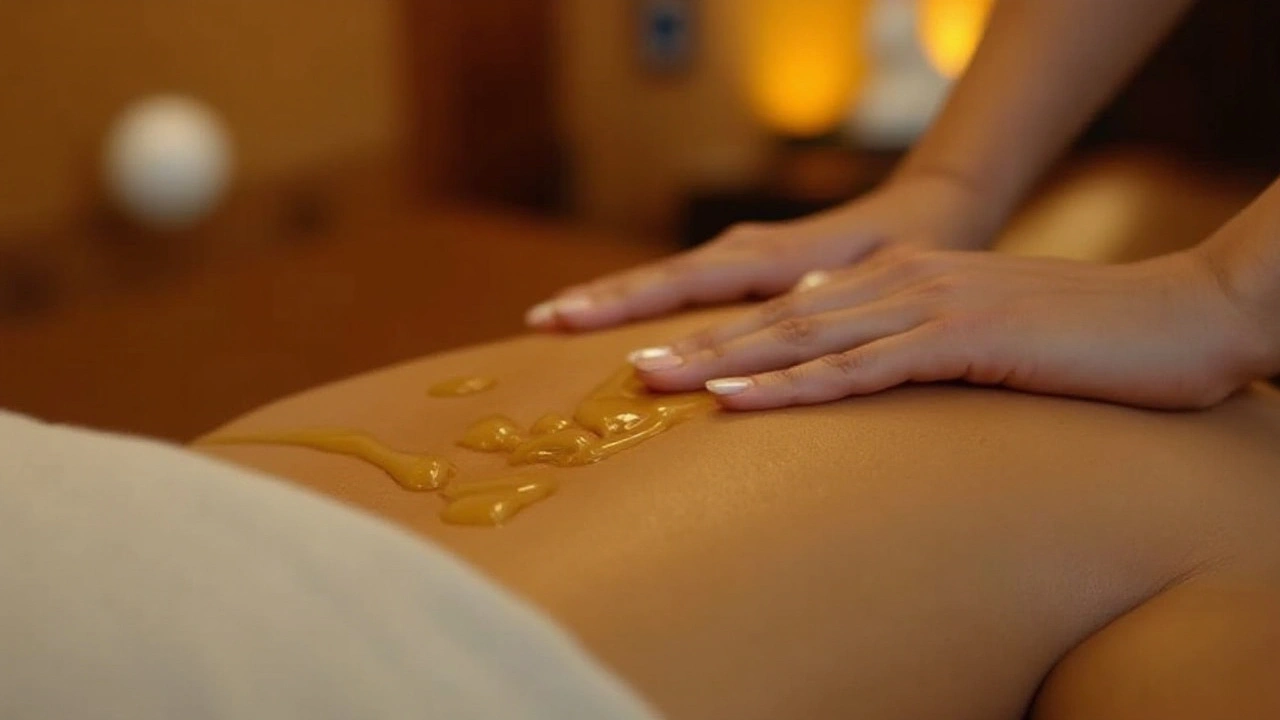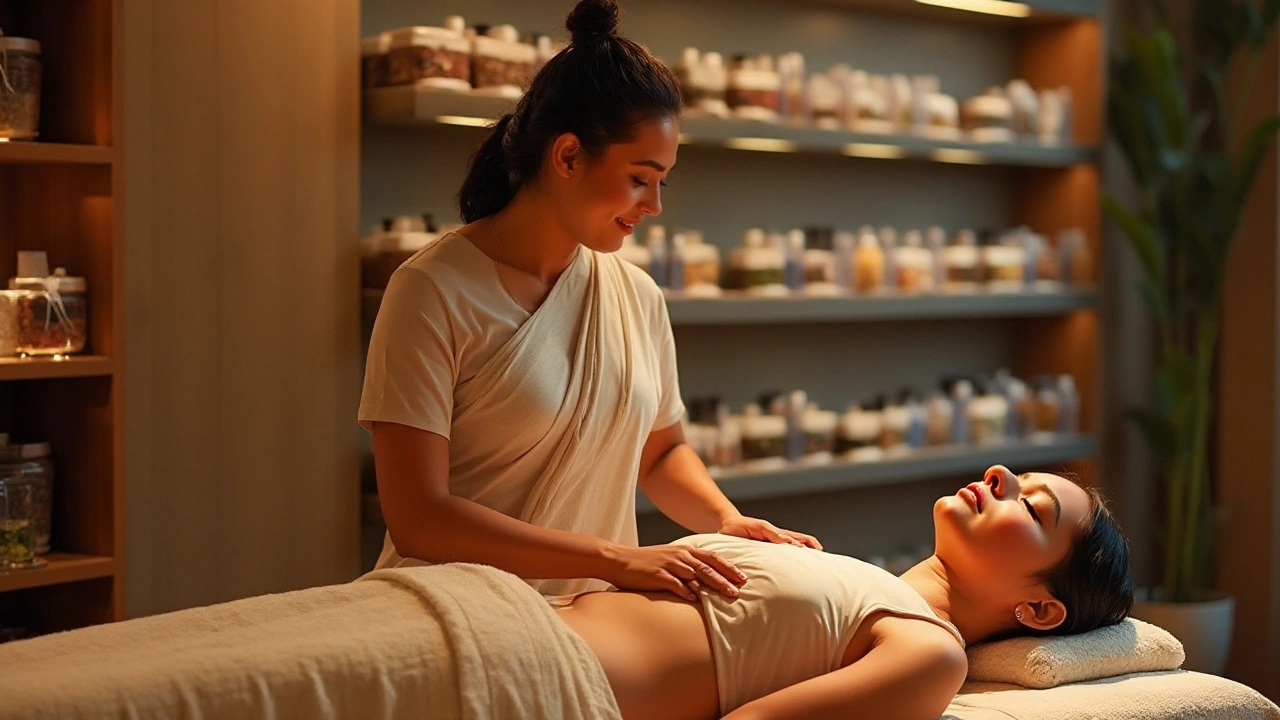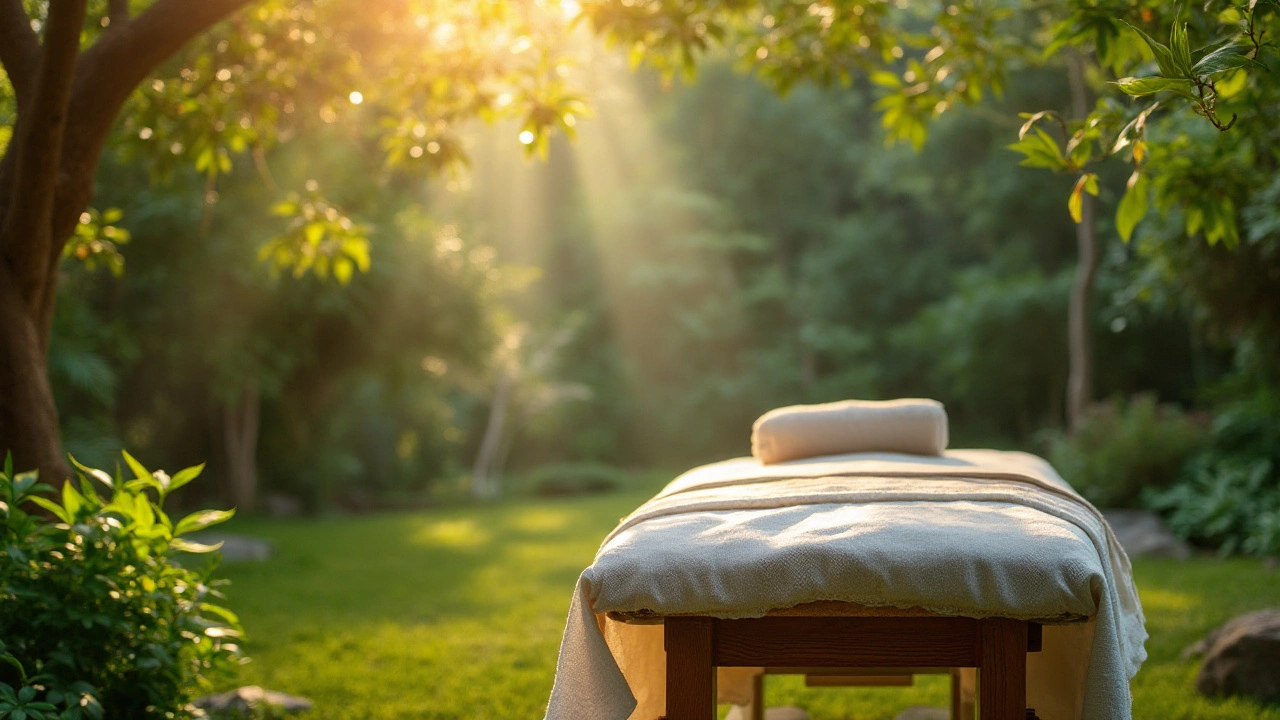The world moves at an unfaltering pace, and often, the quest for relaxation feels unattainably distant. Yet, hidden within the folds of antiquity lies Ayurvedic massage, a traditional practice offering profound relaxation and balance. This ancient art from India is not just a massage; it’s an experience that envelops the body in serenity and aids holistic health.
Steeped in centuries-old wisdom, Ayurvedic massage employs specific techniques with natural oils to tap into the body’s innate ability to heal itself. It’s a journey that connects mind and body, enabling a sense of well-being that goes beyond the physical. Whether you're a seasoned wellness enthusiast or a curious newcomer, understanding this craft can transform how you view personal health.
- Historical Roots and Philosophy
- Techniques and Practices
- Health Benefits
- Tips for Incorporating Ayurvedic Massage
Historical Roots and Philosophy
Delving into the pot of ancient remedies, Ayurvedic massage stands as a beacon of holistic health and subtle luxury that echoes through the annals of history. Its roots trace back over 5,000 years to the Indian subcontinent, entwined with the rich tapestry of Ayurveda—a revered health system that translates to "the science of life" in Sanskrit. This practice embraces the concept that balance exists at the heart of good health, marrying the mind, body, and spirit through a unique flow of techniques that has stood the test of time.
Ayurvedic massage is underpinned by the philosophy that the universe comprises five elements: earth, water, fire, air, and ether. Humans, as a microcosm of the universe, thus embody these elements. Institutions within Ayurveda call these doshas—Vata, Pitta, and Kapha—which govern physical and psychological functions. Each person has a unique constitution, affected by lifestyle and external factors. The massage, therefore, seeks to restore doshic balance by using oils and methods tailored to one's dosha. Arching its principles into contemporary times, Ayurvedic teachings are now often interwoven with modern wellness trends.
The Wisdom of the Ages
For millennia, Ayurvedic massage has drawn upon the power of touch, utilizing ancient techniques recorded in the Vedic texts. These canons serve as a source of spiritual and physical knowledge. As Robert Svoboda, the noted Ayurveda expert, once said,
"Ayurveda is more than just a medical system; it explores life's purpose and makes a roadmap to succor us along the way."Such richness underlines its practice, making it not merely a luxury but a necessity for those seeking a deeper connection with their own body and mind.
The Legacy Continues
In today’s fast-paced universe, Ayurvedic massage finds itself interpreted anew, yet the essence remains unchanged. It's a dance of tradition and individuality, enveloping one like a warm embrace that reminds us of our potential for serenity and balance. With Ayurvedic massage now included in wellness retreats from Bali's verdant retreats to the spiritual enclaves of Bhutan, its practice is ever-evolving, yet immutable. The lessons of ancient sages continue to inspire, with practitioners committed to offering this timeless gift to anyone willing to partake in its benefits. In embracing Ayurvedic massage, we engage not only with history but also with a living wisdom that remains as significant today as it was millennia ago.

Techniques and Practices
Ayurvedic massage is a distinctive therapeutic practice, deeply intertwined with the principles of Ayurvedic medicine—a holistic system of healing that has evolved in India over 3,000 years. This massage practice, rooted in the ancient Sanskrit word 'Abhyanga', refers to the rhythmic application of oil over the body. Each session is unique, crafted to suit individual needs, combining the prowess of touch with the healing properties of herbal oils. The selection of oil plays a crucial role, often tailored based on one's body type or 'dosha', which according to Ayurveda, governs the physical and mental disposition of an individual. There are three primary doshas: Vata, Pitta, and Kapha, and finding a balance among them is believed to foster health and harmony. The therapist's fingers, palms, and even elbows could be engaged in this deeply nourishing practice, employing long strokes, circular movements, and marma point stimulation—energy pathways similar to acupressure points—to enhance the flow of Prana or life energy.
One of the distinguishing features of an Ayurvedic massage compared to Western techniques is the generous use of natural oils. These oils, often warmed for enhanced absorption and comfort, are believed to carry medicinal properties that rejuvenate and detoxify the body. Popular choices include sesame oil, coconut oil, mustard oil, and ghee infused with herbs like ashwagandha, bhringaraj, and brahmi, each chosen to address specific health concerns and dosha imbalances. The abundance of oil not only facilitates smooth and gentle strokes but also nurtures the skin, a reflection of the body’s inner health. As the oils penetrate the skin, they impart their therapeutic benefits, often leading to improved texture and repaired tissues.
The experience of an Ayurvedic massage is a meticulous dance that involves synchronized movements, often performed by two therapists working rhythmically. According to the esteemed Ayurvedic practitioner Dr. Vasant Lad, "Abhyanga is an anointing practice of kneading the muscles with warm oil to mobilize deeper seated toxins, and enhance Deepak, our digestive fire." This kind of comprehensive touch therapy may last anywhere between 60 to 90 minutes, during which the body experiences a systemic rejuvenation. Muscle knots begin to dissolve; stress dissipates, and a deep relaxation sets in, often lulling the recipient into a meditative state. Ayurvedic massages often integrate specific breathing techniques and soft chanting as well, further grounding the body’s energies.
Ayurvedic practice sees each patient as a whole—mind, body, and spirit—rather than focusing solely on symptoms. Hence, Ayurvedic massage is often just one facet of a comprehensive healing plan, which might include dietary adjustments, herbal remedies, and lifestyle changes. Practitioners might suggest rituals such as dry brushing before the massage to stimulate lymphatic drainage or a steam bath afterward to enhance the removal of toxins. The aim is to induce balance and well-being throughout the body. While the objective is wellness, these specific Ayurvedic massage techniques are also lauded for their ability to support mental health, alleviate anxiety, and promote a sense of grounding.
In today's fast-paced world, many people are rediscovering the importance of touch and the role it plays in holistic health. Ayurvedic massage stands out not only for its ancient lineage and spiritual underpinnings but also for its practical approach to wellness. By incorporating these time-honored techniques into modern life, individuals can tap into a profound source of healing that respects their unique body constitution, bolstering health and vitality in a way that is personalized and deeply nurturing.

Health Benefits
In the realm of ancient practices, few are as cherished or as effective as Ayurvedic massage in promoting holistic health. The practice is deeply embedded in the history of Ayurveda, a 5,000-year-old system that holds the equilibrium of body, mind, and spirit as the cornerstone of wellness. Experts today acknowledge that its benefits are not merely anecdotal; instead, they are proven through both ancient wisdom and modern validation. This time-honored technique is renowned for its ability to enhance circulation, which is crucial for nourishing and detoxifying bodily tissues. Improved circulation promotes a healthy glow to the skin and also stimulates the natural lymphatic drainage, helping eliminate toxins more effectively than many traditional methods.
Another significant benefit lies in its prowess to reduce stress and anxiety. In our fast-paced modern lives, stress management becomes pivotal to ensuring overall health. Ayurvedic massage uses rhythmic, flowing massages that calm the nervous system instantly and bring about a sense of deep relaxation. This helps in lowering cortisol levels, which over time, contributes to steady mood regulation and better sleep patterns. Moreover, its emphasis on natural herbal oils enriches the therapeutic experience, with scents like lavender and sandalwood offering aromatherapeutic advantages that alleviate mental tension.
The massage is also lauded for its impact on pain management. By focusing on specific points on the body known as 'marma' points, it releases muscular knots, alleviates joint stiffness, and increases flexibility. A growing body of research indicates how effective these techniques are in chronic pain conditions, affirming the practice as a complementary treatment for issues such as arthritis, back pain, and migraines. The holistic approach not only addresses physical discomfort but also the emotional pain trapped within muscles, often leading to surprising revelations about one’s psyche.
Interestingly, Ayurveda views digestive health as a focal point of overall well-being. The abdominal techniques used in Ayurvedic massage stimulate the 'agni' or digestive fire, enhancing metabolism and aiding in efficient nutrient absorption. This connection between digestion and massage underscores the importance of a healthy digestive system to maintain vitality. Such invigorating techniques not only improve physical digestion but also aid in processing emotional experiences, promoting conscious emotional release.
Ayurveda expert Dr. Vasant Lad states, "The body and mind are not separate; their relationship is integral and inseparable. The health of one affects the other."
Finally, regular sessions contribute to a balanced lifestyle by aiding in body awareness. By paying attention to subtle cues during a massage, individuals cultivate mindfulness and gratitude towards their own bodies, fostering a deeper appreciation. Through Ayurvedic massage, one embarks on a path of self-discovery, understanding dynamics that govern physical and emotional responses, and cultivating a nurturing relationship with oneself.

Tips for Incorporating Ayurvedic Massage
Embracing Ayurvedic massage in your routine can be a transformative journey, designed to enhance your physical and mental well-being. The first step starts with understanding the principle of Doshas - the bodily energies, Vata, Pitta, and Kapha, each representing elements and influencing various aspects of your health. Begin by identifying your predominant Dosha through online questionnaires or, ideally, a consultation with an Ayurvedic practitioner. This helps you select suitable oils and techniques tailored to your unique constitution, making your experience more effective.
Once you've identified your Dosha, select massage oils that best complement it. For instance, if you align more with Vata, a nourishing oil like sesame can ground restless energy. Pitta types benefit from cooling oils such as coconut, while Kapha people often choose lighter oils like sunflower. Heating your chosen oil before application is crucial as it enhances absorption and relaxation. Gentle warming also imbues the attendant with a sense of ritualistic care, elevating the practice from mere routine to sacred ceremony.
Learning the massage techniques can create a more profound Ayurvedic experience. Abhyanga, a popular method, involves a rhythmic application of oil in circular motions over joints and long strokes over limbs. The method is both calming and invigorating, stimulating circulation and removing toxins. Practicing self-massage not only helps to connect with your body but also induces a meditative state, relieving stress and recharging your energy. Frequent practice, even briefly each morning, can establish a restorative daily rhythm.
Apart from technique, setting the right ambiance enhances the sensory experience of Ayurvedic massage. Beginners can create a soothing environment by using soft lighting and calming music, letting serene fragrances from essential oils, like lavender or sandalwood, drift through the room. Such elements make the session feel special, allowing the mind to unwind completely. Regular sessions, even once a week or month, can dramatically improve your mental health, lowering anxiety and nurturing emotional balance.
Wellness through Ayurvedic massage isn't confined to the physical act of massage alone; mindfulness plays a key role. Focus on your breathing during the session, maintaining a gentle, mindful rhythm. This connects mind and body, aligning them in a harmonious flux of energy. Some practitioners impart mantras or meditative prayers to deepen this state, adding verbal cues to reinforce relaxation, awareness, and gratitude. Together, these techniques envelope the spirit in serenity, promoting tranquility from within.
Incorporating Ayurvedic practices requires patience and openness, but the rewards are manifold. As the wellness expert Dr. Deepak Chopra once noted,
"Ayurveda teaches us to cherish our innate-nature - 'to love and honor who we are', not as what people think or tell us, 'who we should be'."This philosophy not only guides massage practices but also supports a holistic approach to life, helping you achieve a balanced lifestyle filled with peace and rejuvenation.

